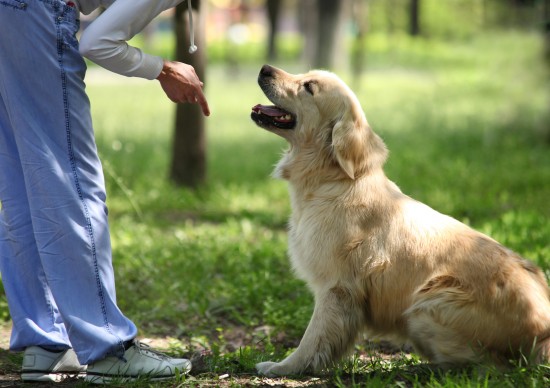

Training your own dog or puppy from scratch can be a challenge for even the most experienced of dog owners, and there are a wide variety of different schools of thought regarding the most effective and beneficial method of training the dog. The two main types of training protocols that most dog owners are aware of are called positive reinforcement and negative reinforcement respectively, and up until as recently as ten to fifteen years ago, negative reinforcement was thought to be the most effective way of training the dog.
Today, positive reinforcement is widely promoted as the best and fairest method of dog training, and the one most likely to yield positive results. Even large organisations that employ a lot of working dogs in high level and important roles, such as the police and the military, have changed their dog training techniques and protocols significantly to reflect this development in knowledge.
If you are not totally sure of what positive reinforcement or negative reinforcement training techniques involve, or how to use them, read on for an explanation of these two key dog training techniques.
Positive reinforcement is a very straightforward method of dog training, and one that enables the dog to learn new skills and build upon their obedience training by means of a positive reaction from the dog yielding a positive reward from the handler.
First of all, positive reinforcement uses a positive response and possibly a treat from the handler to teach the dog that what they have done is what has been asked of them, teaching the dog to repeat the activity upon command in the hope of achieving another reward. This method helps the dog to understand any given training command quickly, and also, reinforces their compliance with the command in perpetuity by attaining a treat or a word of praise when they continue to obey.
Positive reinforcement focuses on rewarding the good and ignoring the bad in terms of behaviour, and does not involve any negative stimulus such as telling the dog off or physically chastising them for mistakes or getting things wrong.
Negative reinforcement involves looking for compliance within the dog, and rather than rewarding for positive compliance, telling the dog off or negatively reacting to non-compliance. For instance, while positive reinforcement would involve withholding a treat until a dog gets a skill right and then rewarding the dog with the treat, negative reinforcement would involve chastising the dog when they get things wrong, until they come to develop a skill based on avoiding the negative response that is achieved from non-compliance.
Negative reinforcement may involve telling the dog off, speaking sharply to them, withholding rewards and treats, or physical chastisement.
Negative punishment is another element of negative reinforcement, which can take on a wide variety of forms. Negative punishment is the element of the training that is involved with providing feedback to the dog for poor performance; for instance, if the dog jumps on the sofa when they are not allowed to, negative punishment might involve physically removing them from the sofa firmly and by asserting physical dominance. It can also take on the simple form of ignoring the dog, which to the dog, is a punishment in and of itself.
Positive punishment is not, as the name implies, an aspect of positive reinforcement, but instead a rather extreme element of negative reinforcement that is generally not recommended. Traditionally, it was a technique used to “break” highly unruly or aggressive dogs, by strongly asserting dominance over the dog physically, and encouraging subservient behaviour.
Positive punishment might involve using a choke chain to apply sharp pressure to the neck of the dog, releasing the pressure when the dog complies; or physically smacking the dog or otherwise administering physical punishment for bad behaviour.
Modern research and understanding of the minds of dogs indicates that positive punishment may in fact contribute to unruly or aggressive behaviour in problem dogs, rather than solving the issue.
While the whole philosophy of positive reinforcement is often assumed to be that a dog is rewarded for good behaviour and bad behaviour is not dealt with, this is not entirely true.
There are various ways of indicating to a dog undergoing positive reinforcement training that something they have done is bad or wrong, without resorting to harsh treatment or physical punishment.
Ignoring a dog that is acting out or refusing to comply with commands is the main manifestation of this; mentally putting the dog “in the dog house” for a time out until they are more amenable to training and trying again. It is also totally appropriate to use firm commands and sharp words such as “no!” as part of positive reinforcement training, to bring the dog up short, catch their attention and divert them into a more positive activity.
 Interesting Facts About A Cats Nose
Interesting Facts
Interesting Facts About A Cats Nose
Interesting Facts
 Why Is Chocolate Harmful To Dogs?
Why Is Chocolate
Why Is Chocolate Harmful To Dogs?
Why Is Chocolate
 Feline Calicivirus (fcv) And How It Is Transmitted
Feline Caliciviru
Feline Calicivirus (fcv) And How It Is Transmitted
Feline Caliciviru
 When Does A Kittens Eyes Change Colour?
When Does A Kitte
When Does A Kittens Eyes Change Colour?
When Does A Kitte
 The Pack Behaviour Of The Domestic Dog Within The Home
The Pack Behaviou
The Pack Behaviour Of The Domestic Dog Within The Home
The Pack Behaviou
Copyright © 2005-2016 Pet Information All Rights Reserved
Contact us: www162date@outlook.com